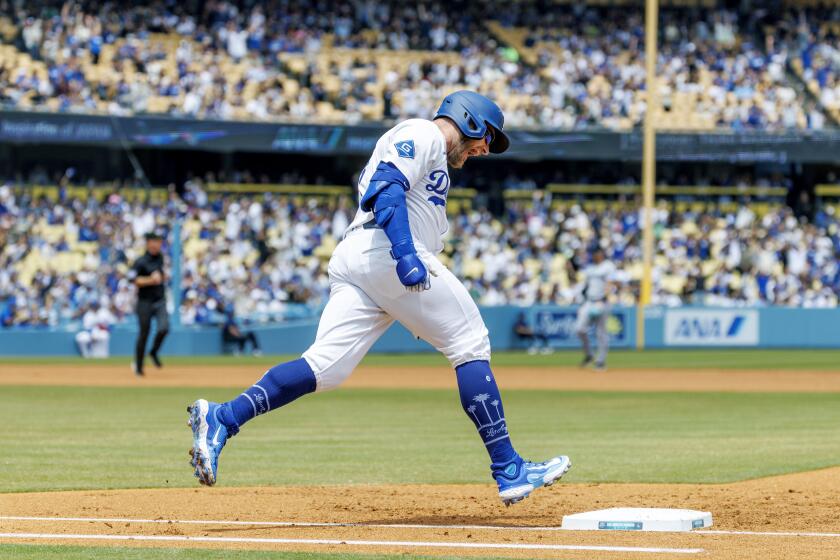‘House’ a home to many moments
- Share via
A
FTER acquiring Babe Ruth from the Boston Red Sox before the 1920 season, the New York Yankees set out to build a stadium. They bought 10 acres of land in the Bronx in 1921 from the estate of William Waldorf Astor for $675,000. Two years and $2.5 million later, Yankee Stadium opened. Next season, the Yankees will open a $1.2-billion stadium and tear down the old one. Tonight, baseball’s elite return for the final All-Star game in the original “House That Ruth Built,” and return to a place that has housed some of the most memorable moments in sports history. For some of the highlights, including the three All-Star games played at the stadium, see Page D5.
Sultan of Swat
Babe Ruth barely kept his 60th home run fair down the right-field line on Sept. 30, 1927. With that blast, Ruth broke his own single-season home-run record of 59, set in 1921.
Gipper game
George Gipp, an offensive star at Notre Dame, received a visit on his deathbed from his coach, Knute Rockne. Gipp told the coach, “Sometime, Rock, when the team is up against it, when things are wrong and the breaks are beating the boys -- tell them to go in there with all they’ve got and win just one for the Gipper.” Rockne decided that day was Nov. 10, 1928, when his Irish traveled to Yankee Stadium to play undefeated Army. Notre Dame won, 12-6.
‘Down goes Schmeling!’
In their first match in 1936, Max Schmeling defeated Joe Louis, a win that Nazi leader Adolf Hitler used to propagandize his belief in Aryan superiority. Two years later, they met again at Yankee Stadium. Hitler called Schmeling before the fight, asking him to win for the Third Reich, but this time, Louis knocked Schmeling out in the first round.
‘Luckiest man . . . ‘
In 1939, Lou Gehrig was diagnosed with amyotrophic lateral sclerosis, the disease that bears his name today. But Gehrig made one last trip to Yankee Stadium to bid fans farewell on July 4. A tearful Gehrig proclaimed to the crowd, “Today, I consider myself the luckiest man on the face of the Earth.” Gehrig died nearly two years later.
Brooklyn’s year
It was 1955 that “next year” finally arrived. The popular mantra of Dodgers fans, “Wait till next year,” began to sound hollow after the Yankees defeated Brooklyn five times in the fall classic (1941, ‘47, ‘49, ‘52, ‘53). But in 1955, the Dodgers finally got back at their crosstown foes, thanks to a game-saving catch by Dodgers outfielder Sandy Amoros with the tying runs on base in the sixth inning, and won the deciding Game 7 in the Bronx.
Thrice perfect
Just after Game 5 of the 1956 World Series ended, and exuberant Yogi Berra leapt into the arms of pitcher Don Larsen. Larsen, a graduate of Point Loma High School in San Diego, had just pitched the only perfect game in World Series history. Thirty-two years later, David Wells, who also attended Point Loma, would take the hill against the Minnesota Twins and pitch a perfect game of his own. Then, on July 18, 1999, it was Yogi Berra Day at Yankee Stadium. Before the game, Berra crouched down behind home plate and caught the ceremonial first pitch from none other than Don Larsen. Larsen and Berra then watched as Yankees hurler David Cone went out and pitched the 16th perfect game in major league history.
‘The greatest game ever played’
Facing the host New York Giants, the Baltimore Colts won the NFL championship, 23-17, on Dec. 28, 1958, on Alan Ameche’s one-yard touchdown run in sudden-death overtime, culminating the game that many consider the greatest in football history.
61*
On Oct. 1, 1961, Yankees outfielder Roger Maris eclipsed Babe Ruth’s single-season home run mark with a shot to right field. Baseball’s commissioner at the time, Ford Frick, said Maris did not break Ruth’s record because the Yankees played 162 games in 1961, eight more than Ruth played in 1927.
The Jackson Three
Facing the Dodgers in Game 6 of the 1977 World Series, Reggie Jackson tied Babe Ruth’s series record by hitting three home runs in one game, lifting the Yankees to their first series title since 1962.
Munson tribute
On Aug. 6, 1979, just hours after speaking in Canton, Ohio, at the funeral of his friend and Yankees captain, Thurman Munson, Bobby Murcer drove in all five runs in New York’s 5-4 win over Baltimore, including a two-run single in the bottom of the ninth to win the game. After the game, Murcer cried in the arms of teammate Lou Piniella and gave his bat to Munson’s widow, Diana.
A little help from a friend
On Oct. 9, 1996, Derek Jeter hit a deep fly ball to right with the Yankees trailing, 4-3, in eighth inning of Game 1 in the ALCS. Orioles outfielder Tony Tarasco reached up at the warning track, but Jeffrey Maier, 12, reached over the wall and caught the ball before Tarasco could. It was ruled a home run, and the Yankees won the game on their way to winning their first of four World Series titles in five seasons.
A city on the mend
Just weeks after the terrorist attacks on the World Trade Center on Sept. 11, 2001, the Yankees made it to the World Series. In Game 4, played on Halloween, the Yankees found themselves down by two runs with two out in the bottom of the ninth. But Tino Martinez hit a two-run home run to tie the score. Then, in the early morning of Nov. 1, Jeter homered in the 10th to give the Yankees the win. The next night, the Yankees were down two runs again with two out in the bottom of the ninth. Jorge Posada was on second base with Scott Brosius at the plate. Brosius homered to left to tie it. The Yankees would win that game in the 12th. Even though they lost the series, their two comeback victories provided relief to a suffering city.
Boston’s year
After winning the first three games of the 2004 American League Championship Series, the Yankees thought they were on their way to another World Series. But Boston took the next three, setting up Game 7 at Yankee Stadium. A stunned crowd watched in disbelief as the hated Red Sox won, 10-3, ending the Curse of the Bambino and completing the biggest playoff collapse in baseball history.
--
--
Begin text of infobox
All-Star games
There have been three previous All-Star games at Yankee Stadium, including one in a refurbished stadium in 1977:
July 11, 1939
Yankee Stadium was chosen to coincide with the 1939 World’s Fair. Ten Yankees were on the team and six were starters -- Red Rolfe, Bill Dickey, George Selkirk, Joe Gordon, Red Ruffing and Joe DiMaggio. Lou Gehrig was there too, as an honorary member of the team, a week after his “luckiest man” speech at Yankee Stadium. One of the big moments for the hometown fans and crowd of 62,892 was DiMaggio’s fifth-inning home run in the American League’s 3-1 victory.
July 13, 1960
From 1959 to 1962, two All-Star games were held each season. The Yankees played host to the second in 1960, two days after the first All-Star game. Only 38,362 attended. Seven Yankees represented the AL -- starters Whitey Ford, Yogi Berra, Mickey Mantle, Roger Maris and Bill Skowron, and reserves Jim Coates and Elston Howard. Willie Mays returned to the city in which he started his career and went three for four, including a home run, as the National League won, 6-0.
July 19, 1977
DiMaggio was honorary captain for the AL and Willie Mays for the NL. Joe Morgan led off the game with a home run against Baltimore pitcher Jim Palmer as the AL lost, 7-5, in front of 56,683.
Los Angeles Times research
More to Read
Go beyond the scoreboard
Get the latest on L.A.'s teams in the daily Sports Report newsletter.
You may occasionally receive promotional content from the Los Angeles Times.










